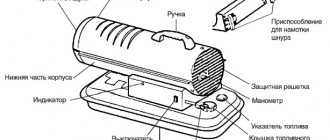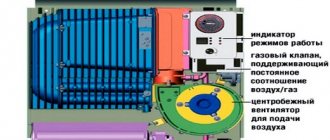The wood-burning internal combustion engine is not a ghost from the distant past. Cars and power plants using wood as an energy source can still be found today. It is worth clarifying: the engine operates on gas obtained from wood by burning it in a certain way. Installations that produce such gas are called gas generators; they have been used in industrial enterprises for quite a long time. But is it possible to make a gas generator with your own hands and is it worth doing? These are the questions that our article aims to answer.
How does a gas generator work?
To understand what benefits a gas generator can have in a household, you need to understand its operating principle, and then its structure. Then it will be possible to estimate the costs of its production, and most importantly, what kind of result will be obtained.
So, a pyrolysis gas generator is a complex of components and assemblies designed to separate a mixture of combustible gases from solid fuel for the purpose of its use in internal combustion engines.
For reference. The designs of generators differ from each other depending on the type of solid fuel burned; we will consider the most relevant of them - wood-burning.
If wood is burned in a closed space, limiting the supply of oxygen, then the output can be a mixture of combustible gases. Here is their list:
- carbon monoxide (carbon monoxide CO);
- hydrogen (H2);
- methane (CH4);
- other unsaturated hydrocarbons (CnHm).
Note. The mixture also contains non-flammable ballast gases: carbon dioxide (carbon dioxide), oxygen, nitrogen and water vapor.
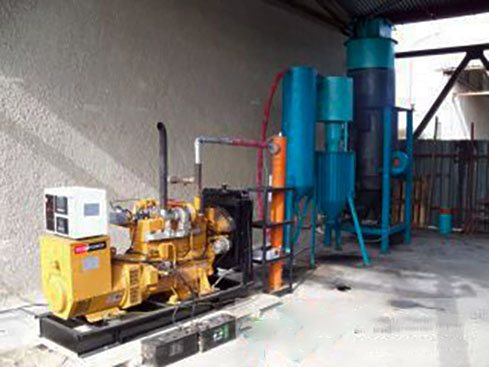
An effective wood gas generator must not only produce a combustible mixture, but also make it suitable for use. Therefore, the entire cycle of obtaining fuel for internal combustion engines can be safely called a technological process consisting of the following stages:
- gasification: wood does not even burn, but smolders when the amount of oxygen supplied is 33-35% of that required for complete combustion;
- primary rough cleaning: volatile particles of combustion products produced by wood gas generators after the first stage are separated using a dry vortex filter - a cyclone;
- secondary rough cleaning: carried out in a scrubber - purifier, where a flow of fuel is passed through water;
- cooling: combustion products with temperatures up to 700 ºС pass through it in an air or water heat exchanger;
- fine cleaning;
- sending to the consumer: this can be pumping fuel by a compressor into the distribution tank or supplying it to the mixer, and then directly to the internal combustion engine.
You can consider the design and operating principle of an industrial gas generator in the technological diagram presented below:

The full gas production cycle is quite complex, since it includes several different installations. The most basic one is a gas generator, which is a metal column of cylindrical or rectangular shape, narrowing downward. The column has pipes for air and gas outlet, as well as an access hatch to the ash pit. The unit is equipped with a lid on top for loading fuel; the chimney is not connected to the body; it is simply missing. The combustion and pyrolysis process taking place inside the column is well reflected by the gas generator diagram:
Without going into the intricacies of the chemical reactions taking place inside the column, we note that the mixture of gases described above is obtained at the exit from it. Only it is contaminated with particles and combustion byproducts and has a high temperature. Having studied the drawings of gas generators of any design, you will notice that all other equipment is designed to bring gas back to normal. Air is forced into the combustion zone by a traction or blowing machine (in simple words - a fan).

It must be said that a homemade wood-burning gas generator is made by home craftsmen with a less complex design and the technology for releasing gas in it is somewhat simplified, which will be discussed below.
How it works
In order to extract natural gas, it is not necessary to search for a deposit and open a well; you can use a pyrolysis boiler. This is a special type of boiler equipment where fuel burns with minimal access to oxygen, breaking down into wood residue (coal) and combustible gas (propylene and ethylene).
Considering that the combustion of pyrolysis gases occurs simultaneously with the fuel, the efficiency of the boiler increases by 1.5-2 times with the same fuel consumption as a conventional boiler.
Slow combustion of fuel (wood, sawdust, pellets, etc.) provides a much longer combustion process (12 hours compared to 3-4 hours in a normal one).

The diagram shows on what principle the pyrolysis boiler works and how the process of formation of combustible (wood) gas occurs.
Being, in fact, a gas-generating equipment, such a boiler performs a number of tasks, namely:
- Produces low-molecular-weight olefins as a result of the combustion of wood and its constituent cellulose.
- Purifies olefins from all foreign impurities, resulting in a clean combustible gas.
- Cools gases by reducing the amount of energy during final combustion of fuel.
A pyrolysis boiler is always divided into 2 chambers, in one of which the main fuel burns with minimal access to oxygen, the second receives exhaust gases and, when air is pumped in, they are burned.
Such optimization of the combustion process allows us to solve two key problems at once - increasing the efficiency of the boiler and the ability to organize a water heating boiler by connecting it to a water jacket.
The pyrolysis process ensures complete combustion of fuel with maximum heat transfer, which ultimately results in more than 35% cost savings.
It is quite possible to make a gas-fired wood-burning boiler with your own hands, but before that you need to understand the principle of its operation, the design of internal combustion chambers and safety precautions in order to eliminate the slightest violation of technology.
Myths about gas generators
On the Internet there are often many unsubstantiated claims about the operation of such units and conflicting information is given about the use of gas generators. Let's try to dispel all these myths.
The first myth sounds like this: the efficiency of a gas generator unit reaches 95%, which is disproportionately greater than that of solid fuel boilers with an efficiency of 60-70%. Therefore, heating a house with its help is much more profitable. The information is incorrect from the outset; you cannot compare a household gas generator for a home and a solid fuel boiler; these units perform different functions. The task of the first is to produce flammable gas, the second is to heat water.

When talking about generating equipment, its efficiency is the ratio of the amount of product obtained to the volume of gas, which can theoretically be isolated from wood, multiplied by 100%. Boiler efficiency is the ratio of the generated thermal energy of wood to the theoretical calorific value, also multiplied by 100%. In addition, not every biogas plant, let alone a gas generator, can extract 95% of combustible fuel from organic matter.
Conclusion. The essence of the myth is that they are trying to compare mass or volume with units of energy through efficiency, and this is unacceptable.
It is easier and more efficient to heat a house with a conventional pyrolysis boiler, which in the same way releases flammable gases from wood and immediately burns them using the supply of secondary air to an additional combustion chamber.
The second myth is that you can put fuel of any moisture content into the bunker. You can load it, but only the amount of gas released drops by 10-25%, or even more. In this regard, the ideal option is a gas generator that runs on charcoal, which contains almost no moisture. And so the thermal energy of pyrolysis is spent on the evaporation of water, the temperature in the furnace drops, and the process slows down.
Myth three – the cost of heating a building is reduced. This is not difficult to check; just compare the cost of a wood-burning gas generator and a conventional solid fuel boiler, also made by yourself. Plus you need a water heating device that burns wood gases, for example, a convector. Finally, operating this entire system will take a lot of time and effort.
Conclusion. A homemade wood-burning gas generator, made with your own hands, is best used in conjunction with an internal combustion engine. That is why home craftsmen adapt it to generate electricity at home, or even install it on a car.
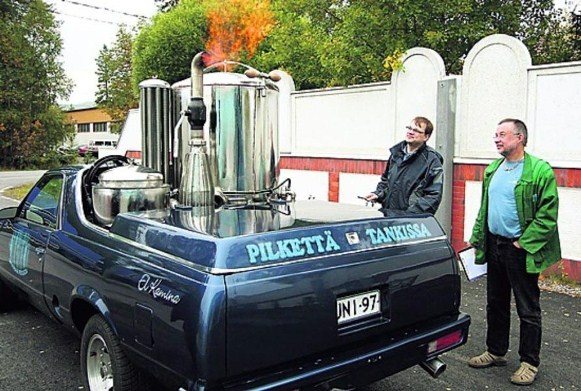
Technical characteristics of gas generating units
| Installation characteristics | UDSO-60 | UDSO-100 | UDSO-150 | UDSO-250 | UDSO-300 | UDSO-400 |
| Power of the heating unit connected to the gas generator, kW | 60 | 100 | 150 | 250 | 300 | 400 |
| Fuel bunker volume, m3 | 1 | 1 | 1,2 | 1,2 | 1,3 | 1,3 |
| Operating time on one fuel load, h | 5 | 4 | 3,5 | 3 | 3 | 2 |
| Dimensions, mm | 230013001900 | 240014002000 | 265015502000 | 290016502000 | 350017102100 | 375017102200 |
| Weight, kg | 1000 | 1150 | 1250 | 1400 | 1480 | 1500 |
The gas generator is designed to produce generator gas from solid fuel (wood waste and other types of biofuel). Producing heat using a gas generator is a two-step process. The first stage is the production of combustible gas in the gas generator reactor (pre-furnace). The second stage is the afterburning of the resulting gas in the boiler furnace or other installations to produce thermal energy. The operation of the gas generator is based on the process of high-temperature conversion of solid fuel without access of air or during the combustion process with a lack of air into a gas called generator gas or wood gas. As a result of thermochemical reactions occurring in the reactor zone of the gas generator, a generator gas is obtained consisting of flammable gases (carbon monoxide, hydrogen, methane), ballast gases (carbon dioxide and nitrogen), water vapor, a certain amount of pyrolysis resins and solid impurities. The composition, calorific value, and yield of the generator gas depend on the conditions of the gasification process, the composition and humidity of the fuel, and the gasification method used in a particular gas generator. When producing generator gas from wood, its calorific value is usually 12-13 MJ/kg, specific gravity - 1.10 to 1.15 kg/m. cube Gas output, on average, is 1.8-2.5 cubic meters. for every kilogram of wood gasified. Due to the high efficiency of the gasification process (producer gas yield is 85-90%), as well as the convenience of using gas as fuel, gasification is a cleaner and more efficient way to produce heat than burning solid fuel directly in the boiler furnace. An important advantage is that low-quality fuel can be used to operate the gas generator - sawdust, shavings, crushed bark.
Automotive gas generator
You need to understand that a gas generator for a car must be quite compact, not too heavy and at the same time efficient. Foreign colleagues, whose incomes are much higher than ours, make the generator housing, cyclone and cooling filter from stainless steel. This allows you to take half the thickness of the metal, which means the unit will come out much lighter. In our realities, pipes, old propane cylinders, fire extinguishers and other available materials are used to assemble a gas generator.
Below is a drawing of a gas generator installed on old UralZIS-352 trucks, and you should use it to guide you when assembling the unit:
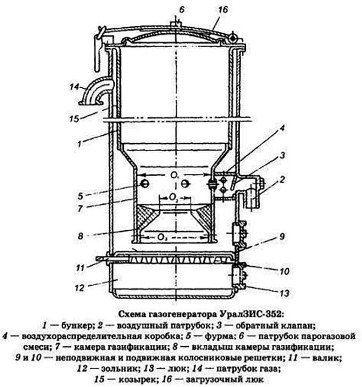
Our craftsmen most often make the outer tank from liquefied propane cylinders; the inner tank can be made from the receiver of a ZIL or KamAZ truck. The grate is made of thick metal, the pipes are made of the corresponding pipe diameter. The lid with clamps can be made from the cut off top of the cylinder or from sheet steel. The lid seal is made of asbestos cord with graphite impregnation.
A coarse filter - a cyclone for cars - is made from an old fire extinguisher or a simple piece of pipe. At the bottom of the pipe there is a conical nozzle with a fitting for unloading ash, and at the top the end is closed with a tightly welded lid. The outlet pipe for purified gases is cut into it, and on the side there is a second fitting where combustion products will be supplied. The functional cross-sectional diagram of the cyclone is shown in the figure:
How to make a wood-burning car with your own hands
If you want to try converting your car to wood burning, there are many obstacles that will stand in your way. When designing a gas generator installation, you will need to make it small, fairly light, and at the same time highly efficient. If finances allow, the best solution would be to follow the path of craftsmen from abroad and use stainless steel for the body of the gas generator itself, the filter and the cooler.
This will give you a noticeable gain in the mass of the entire structure, without losing strength. However, stainless steel will cost you a pretty penny, and therefore domestic craftsmen often replace it with ordinary steel.
The image below shows a diagram of the most advanced automotive gas generator unit, which was equipped with production cars (we are talking about the UralZIS-352 truck, produced in the 1950s). It is its design that is best to focus on when assembling your gas generator:
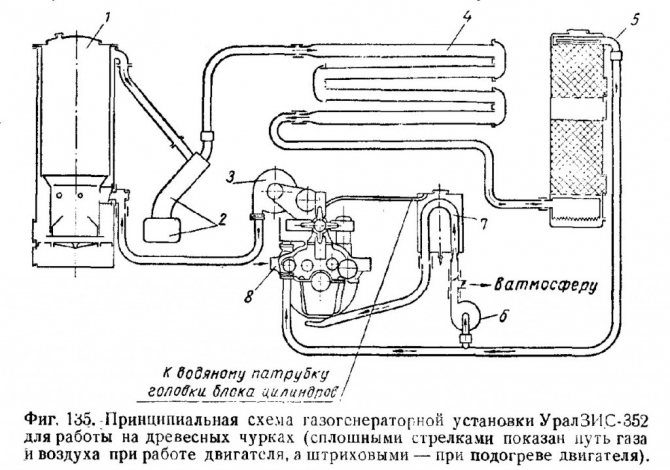
First, you will need to make an outer container - a strong iron barrel or a rolled and welded sheet of metal with a thickness of at least 1 mm is perfect for this purpose; for the inner container, a gas cylinder (for propane) or a receiver from a truck (KAMAZ, for example) will do. Be sure to cut a door into the housing to access the ash pan, otherwise you will not be able to clean it. A neck should be located at the bottom of the combustion chamber - resins will be deposited there. The grate can be easily made from durable fittings, and for the nozzles you will have to find pipes of a suitable size and diameter. A sheet of metal 5 mm thick makes an excellent lid and bottom. Use asbestos cord as a seal (don't forget to impregnate it in the form of graphite grease).
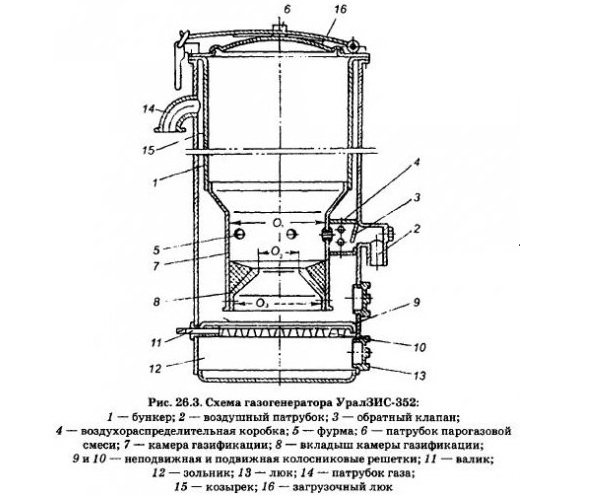
You can use a used fire extinguisher on the coarse filter. In the lower part it is equipped with a cone-shaped nozzle with a fitting, and a pipe is welded on top through which the purified gas will exit. On the side, another fitting is cut into the body to supply combustion products. The general diagram of the cyclone is shown below:
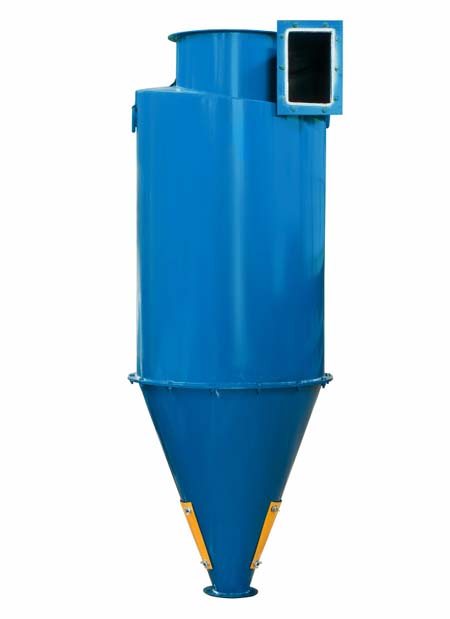
Since the gas mixture has too high a temperature, it cannot be used in an internal combustion engine. Therefore, the gases need to be cooled. As a cooler, you can use either an ordinary “accordion”, used in heating systems, or a more advanced bimetallic radiator, placing it so that it is well blown by the incoming air flow.
After the cooler, the gases must be cleaned again using a fine filter. The housing from an old fire extinguisher will also work here, but choose the filter element at your discretion. Units and assemblies should be combined according to this diagram:
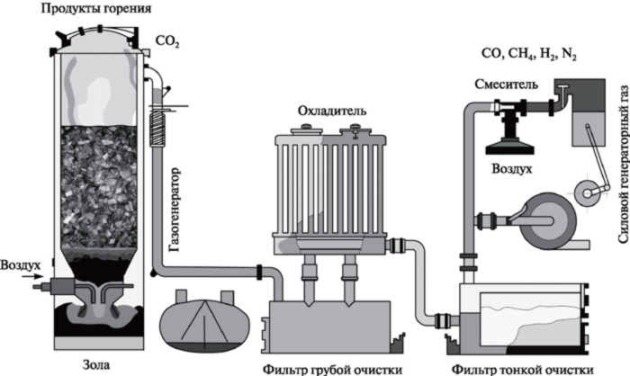
In addition, you will need 2 more parts. The first of them is a mixer with which you will regulate the fuel-air mixture for the internal combustion engine. The second is a fan with a relay, which is necessary to pump gas during ignition (after starting the engine, a vacuum appears in the system, and the fan must be turned off at this stage). By the way, the fan is installed in an air distribution box equipped with a check valve. The box is not part of the gas generator, but is installed separately.
Conclusions and recommendations
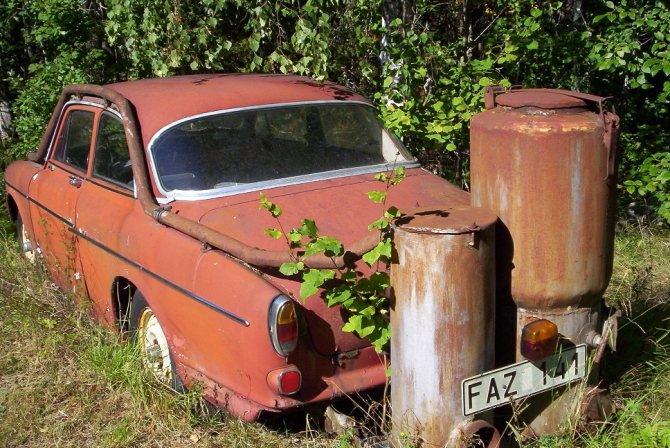
Although the idea of converting a car from gasoline to wood seems very attractive, an equivalent replacement will not work. Despite all the advantages of a gas generator, an engine running on a mixture of flammable gases is simply unable to develop power comparable to a liquid fuel engine. As a result, the dynamics leave much to be desired (even 70-80 km/h is a practically unattainable speed). It’s another matter if a gas generator installation is created for the purpose of heating housing in non-gas-free settlements. In this case, this is a very good option, which is definitely worth paying attention to.
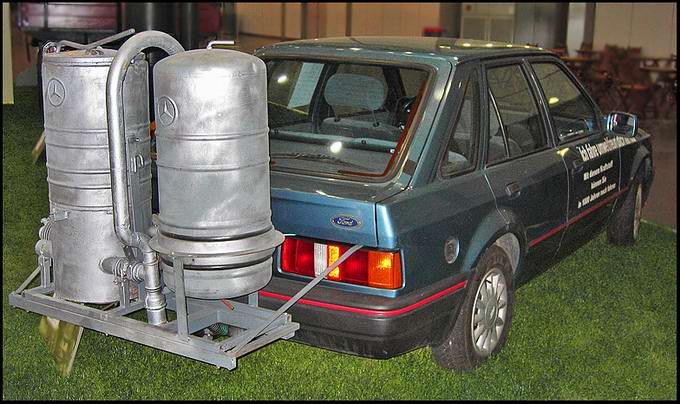
Wood-burning car? And is it possible to make such a car with your own hands?
Looking at gas station signs with gasoline prices, every now and then a desire arises to switch the car to a cheaper type of fuel.
One of the popular options is converting a car to gas. But not everything is smooth here either. Against the backdrop of events in the gas and oil sector, gas prices may rise, which will make work pointless.
Problems with energy resources are obvious and no one yet knows how this will end for the end consumer.
If you decide to redo it, then you should choose independent and truly effective methods. And here gas-generating cars or, in simple terms, “wood-burning cars” come first in terms of savings.
HISTORY OF CREATION AND DEVELOPMENT, EXAMPLES OF WOOD-POWERED VEHICLES
Despite the slow progress of the topic of gas-generating machines, the history of such developments is very rich. So, back in 1823, the Russian inventor Ovtsyn I.I. developed an apparatus for distilling wood. It is based on the most common “thermal lamp”.
The main feature of the installation was the use of the main pyrolysis products - illuminating gas, acetic acid and tar, as well as charcoal.
Almost forty years later (in 1860), Etienne Lenoir, a Belgian waiter with engineering “inclinations,” made his contribution to science. It was he who first acquired a patent for an internal combustion engine operating on lighting gas.
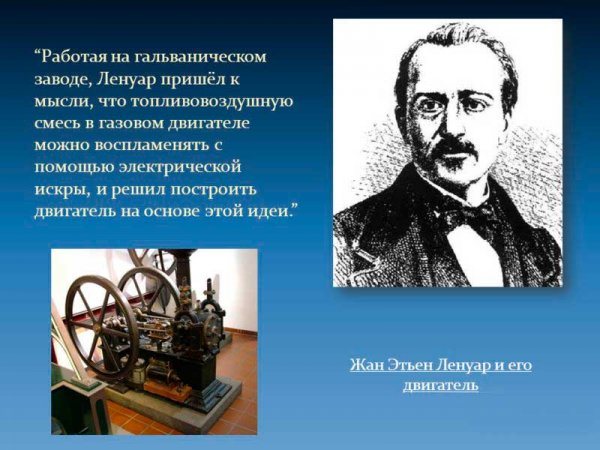
Two years later, the installation of the newly minted genius appeared on an 8-seater open omnibus.
But in 1878, when the more powerful 4-stroke gas engine of Nicholas Otto was presented to the public, Etienne Lenoir's development was quickly forgotten. At the same time, the new device had a higher efficiency: 16% for Otto versus 5% for Lenoir.
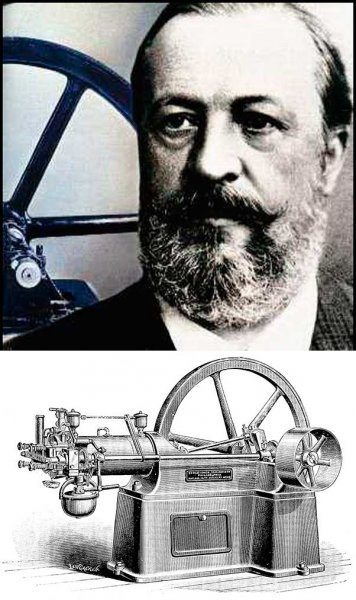
Another two decades later, in 1883 (from 1860), a new concept of combining a conventional internal combustion engine and a gas generator appeared.
The English scientist E. Dawson managed to combine two devices in one box.
The resulting device could be safely installed on any equipment and safely operated. Over time, E. Dawson’s development became known as “Dawson gas.”
In 1891, Evgeniy Yakovlev (lieutenant of the Russian Navy) distinguished himself. He managed to build an entire plant for the production of kerosene and gas engines. The place for construction was St. Petersburg.
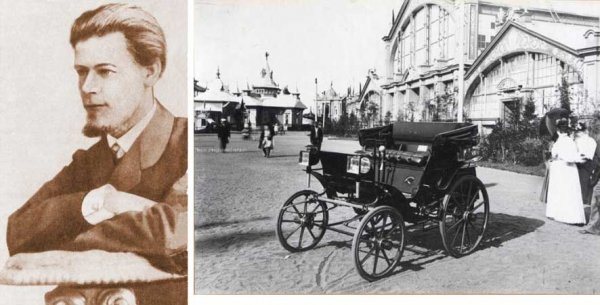
Over time, the plant ceased to exist due to the inability to resist competition with gasoline and diesel engines.
The year 1900 can safely be called the year of production of the first gas-generating car using charcoal and wood as fuel.
The device was developed in France by Frederick Winslow Taylor, and a patent was obtained a little later (in 1901).
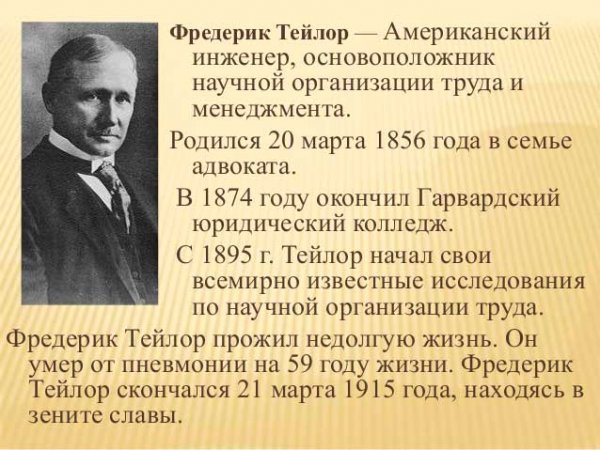
Subsequently, new and more interesting developments in this area appeared. So, in 1919, Georg Imbert (an engineer of French origin) developed a reverse-type gas generator.
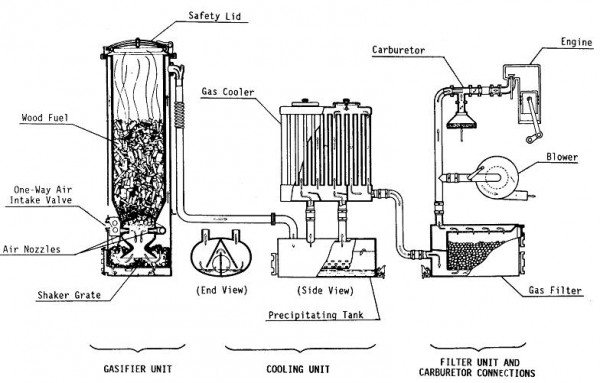
Already in 1921, the first cars with engines operating on this principle appeared. It was then that speculation arose about the likely competition of a gas-generating car with diesel or gasoline engines.
Over time, Germany also distinguished itself, where during the war not only wood-burning gas generators became widespread, but also devices capable of operating on special briquettes consisting of lignite dust and crumbs.
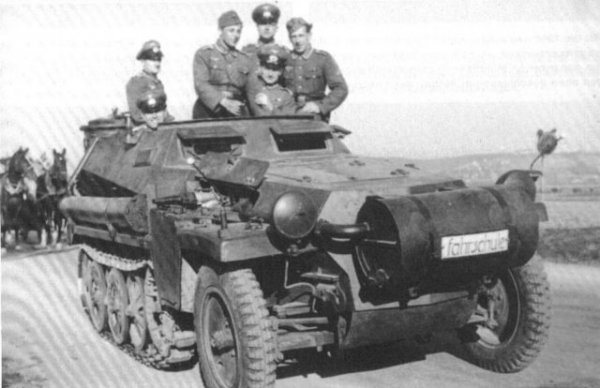
The first trucks with gas generators were very slow - they could hardly reach a speed of 20 kilometers per hour.
Despite this, by 1938 the popularity of gas-generating cars was so great that the total number of such cars was about nine thousand.
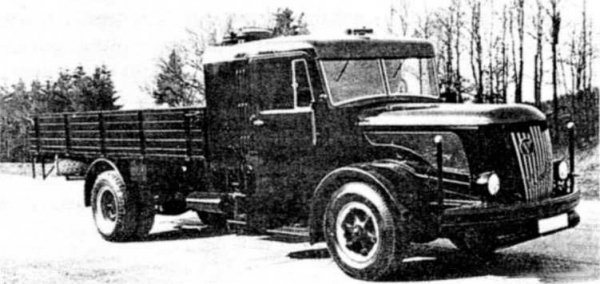
Three years later (by 1941), their number increased fiftyfold. For example, in Germany, the number of “wood-burning” cars has grown to 300 thousand copies.
The Soviet Union also tried to keep up. Here, the first tests of gas generator cars took place in 1928. The car was powered by a Naumov engine and a Fiat-15 chassis.
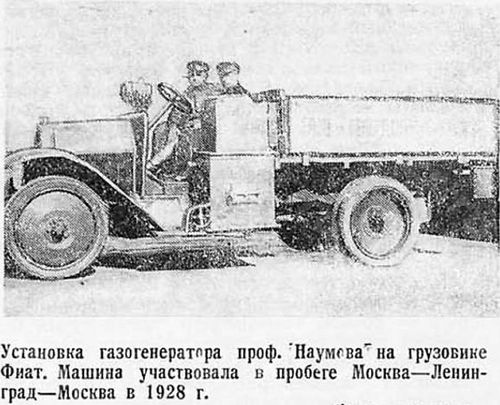
Six years later, the first large run of cars with gas generator engines was organized from Moscow to Leningrad and back.
WOOD-FUELED GAS GENERATOR FOR A CAR – DEVICE AND PRINCIPLE OF OPERATION
The automotive gas generator installation includes the following elements:
- rough cleaners;
- the gas generator itself;
- fine cleaners;
- mixer and ignition fan.
A simple diagram looks like this.
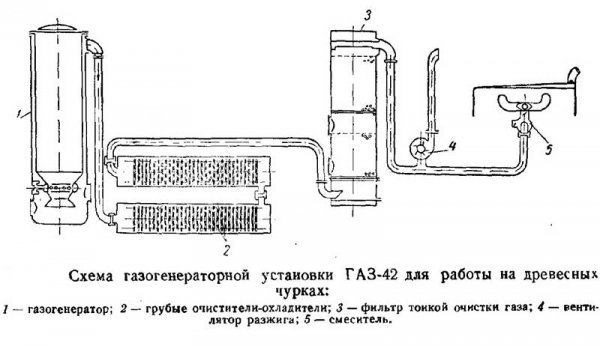
During movement, air is sucked into the gas generator using the thrust of a running motor.
The same thrust helps to “pump out” the flammable gas from the gas generator, as well as supply it to the coarse purifiers, and then to the fine filter.
After mixing with air in the mixer, the finished gas-air mixture is sucked into the engine cylinders.
After leaving the gas generator, the hot and contaminated gas requires additional processing (cooling and cleaning).
To do this, it is passed through a special pipeline that combines a gas generator with a fine filter.
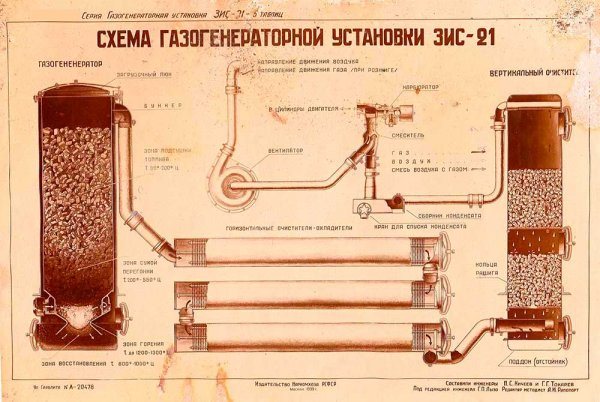
In some designs, the gas passed through a special cooler mounted in front of the water radiator.
Most often, a combined system was used for cooling and cleaning.
Its principle of operation was to change the speed and direction of the gas flow. At the same time, the latter was cooled and cleaned.
The next stage is fine cleaning, for which special “ring” cleaners made in the shape of cylinders were used.
The operating principle of most fine filters was based on the water principle, when gas purification was carried out using water.
In the process of igniting the gas generator, a special centrifugal fan equipped with an electric drive was used.
Due to the fact that the fan needs to pump air through the entire purification system, the device was installed as close as possible to the mixer.
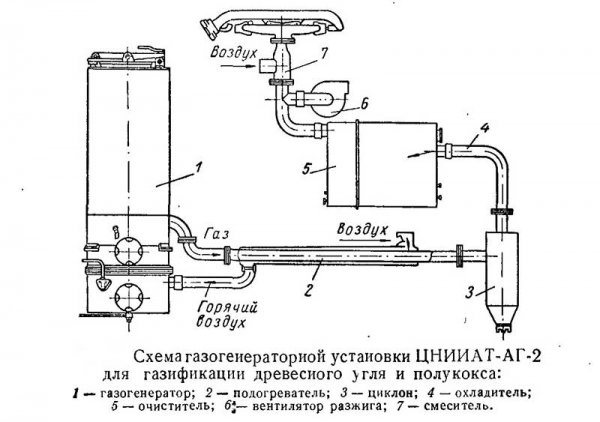
The formation of a combustible mixture is carried out in a car mixer.
The simplest type of device is a special tee in which air and gas flows intersect.
The volume of the mixture entering the engine is controlled using the throttle valve.
The quality of the gas-air mixture is regulated by an air damper.

The main fuel for a gas generating unit is coal briquettes, peat or firewood.
The operating principle of the system is based on partial combustion of carbon. The latter, during combustion, can connect one or a pair of oxygen atoms with the subsequent formation of two elements - carbon dioxide (dioxide) and carbon monoxide (monoxide).
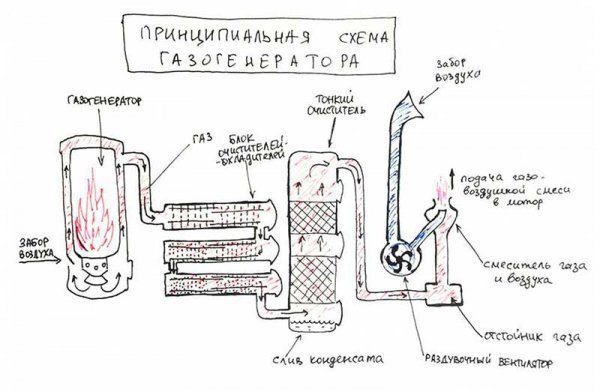
If carbon does not burn completely, then almost 30% of the total energy can be obtained with complete combustion of the material.
As a consequence, the formed gas has a lower heat transfer than the original solid fuel.
It is worth noting that in a gas generator, during the conversion of wood or coal into gas, an exothermic reaction occurs between water and carbon monoxide.
Thanks to this reaction, the temperature of the resulting gas drops and the efficiency increases to 80 percent.
If the gas does not require cooling before use, the efficiency can reach 100%. As a result, 2-stage fuel combustion occurs.
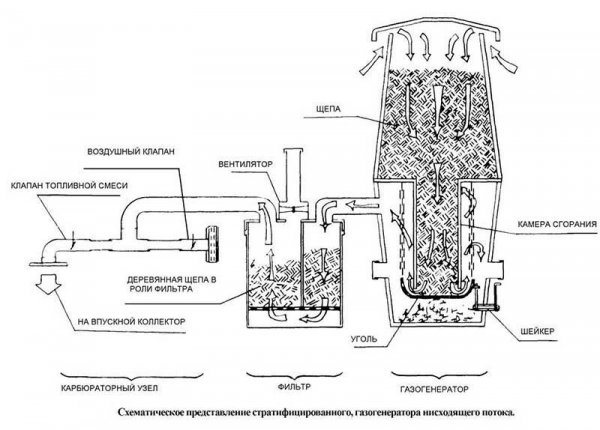
The resulting gas has minimal calorie content due to its mixing with nitrogen.
Due to the fact that smaller volumes of air are needed to burn fuel, such a reduction in calorie content is insignificant.
As for the decrease in engine power when running on gas, the reason is a decrease in the charge of the fuel composition caused by the difficulty of cooling.
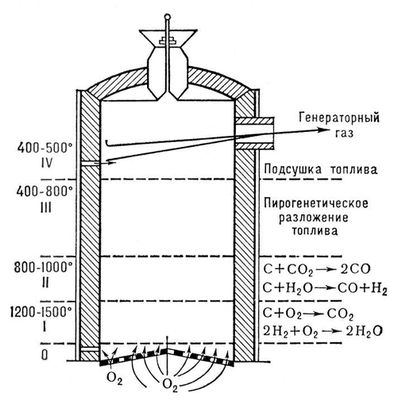
Wood burning gas generator design
Most modern models of gas generators are made of sheet steel .
If we talk about the most common body shape of these installations, it is cylindrical. Note that the gas generator can also have a rectangular body. The legs and bottom are welded to the bottom of the body. They ensure the stability of the unit during use. An important component of the gas generator design is the bunker. It is used to load fuel inside the installation. It has a cylindrical shape and is manufactured using mild steel. The hopper is installed inside the gas generator housing and securely secured with bolts . There is an asbestos seal or a regular gasket on the edges of the hatch cover that leads into the bunker.
Another important component of the gas generator is the combustion chamber. It is located at the bottom of the bunker. In its manufacture, heat-resistant steel is most often used. Sometimes ceramics are used to finish the inside surface of this chamber. It is in this chamber that combustion of solid fuel occurs.
The resin cracking process occurs at the bottom. For this purpose, there is a neck made of chrome steel, which has high heat-resistant properties. The gasket is located between the gas generator body and its neck. Asbestos cord is usually used as a gasket .
The tuyeres, through which air is supplied in these installations, are located in the combustion chamber in its middle part. In appearance, these are holes of a certain caliber. They have a connection to the air distribution box, which is connected to the atmosphere. Heat-resistant steel is used as a material for the manufacture of tuyeres and distribution boxes.
A check valve is present at the outlet of the air distribution box. Thanks to it, flammable gas is prevented from escaping from the gas generator. To increase the power of the unit, a fan is installed in front of this box. It also makes it possible to use fuel with high humidity. A running fan forces air inside the case.
The grate is used to maintain hot coals. If we talk about its location, then in the installation it is located at the bottom of the generator. Burnt coals, turned into ash, easily penetrate through the grate holes into the ash pan. To make it possible to clean the grate from slag, the middle part is made movable. A special lever is provided to rotate the cast iron grate.
The gas generator body also contains loading hatches, which are equipped with lids that close quite tightly. The top hatch is sealed with asbestos cord. There is a special shock absorber on the cover mount. It is a spring that lifts the lid when there is excess pressure inside the chamber. Two loading hatches are also located on the side of the hull.
- The first one is at the top. Its main purpose is to add fuel to the recovery zone when using the unit;
- The location of the second is the lower part of the body, and it is used mainly for removing ash.
Gas is sampled in the recovery zone. It is carried out through a pipe. Gas pipeline pipes are connected to it by welding. It is not at all necessary for the newly produced gas, which is in a hot state, to be removed outside the housing. It can be used to heat or dry fuel if high-humidity solid fuel is used. To do this, it is fed into the loading chamber. In order for it to flow there, it is necessary to run an outlet gas pipeline in a ring around the chamber, between the installation body and the bunker.
The fine filter is located behind the gas generator housing. In its appearance it represents several pipes that are filled with filter elements. Before entering this filter, the gas passes through a cooler. When it is purified, the gas enters the mixer, where it is mixed with air. And only then the mixture enters the internal combustion engine.
When the combustion process of fuel occurs in the combustion chamber, it is oxidized by air, which enters through the chamber tuyeres from the air in the distribution box. The resulting flammable gas moves to a coarse filter, where it is cleaned and subsequently cooled. And then it enters the fine filter, after which it enters the mixer . From the mixer, the resulting mixture enters the internal combustion engine.
DO-It-Yourself WOOD-WOODED CAR
If you wish, you can make a wood-burning car with your own hands.
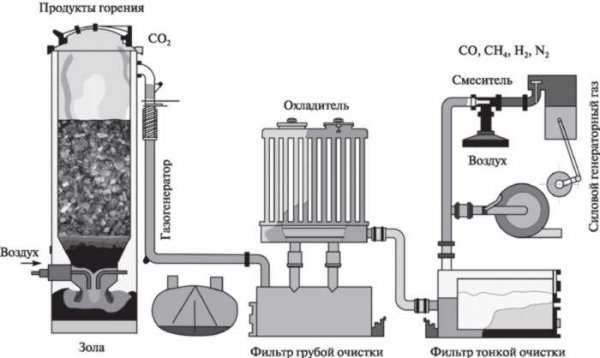
In a simplified version, the algorithm looks like this:
1. A loading hopper is equipped.
As a base, you can use a regular gas cylinder with a capacity of about 40-50 liters. Thanks to this capacity, large volumes of coal can be placed in the cylinder.
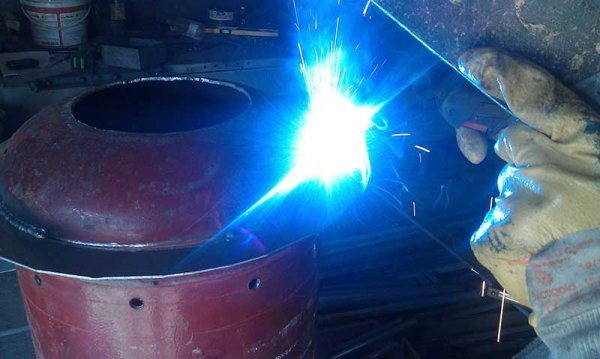
Other materials can also be used.
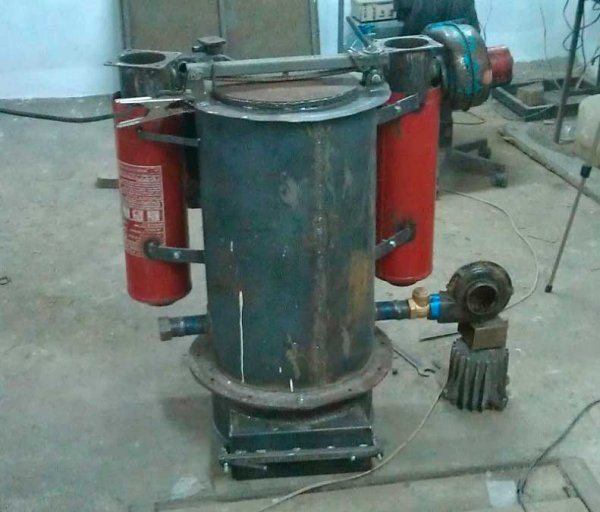
Make sure that the wall thickness is at least three millimeters.
Once a suitable cylinder has been selected, cut out the bottom and cut a neck for loading fuel. The hole for the lid should be wide to simplify the process of loading fuel.
2. A grate is made, which takes on the greatest load.

3. A special lid for the hopper is created.
Fuel (coal) will be loaded through it. If desired, the lid can be made of aluminum, but theoretically any other type of metal can be used.
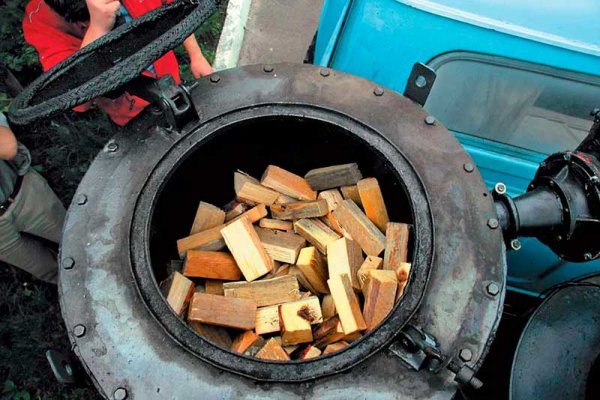
During the installation process, pay attention to the choice of cord - it must be asbestos with mandatory impregnation with graphite.
This is necessary to protect the cord from burning and accidental damage in case of closing or opening.
You can get a high-quality cord at the market or in a boiler room. The optimal diameter of a suitable cord is 13 and 8 millimeters.
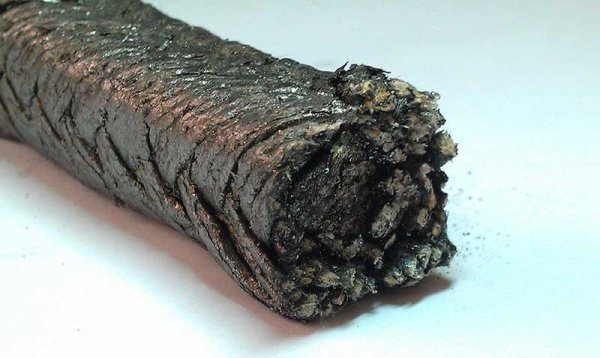
4. A tuyere is made.
The task of this device is to take on the main temperature load. During the installation process, everything is done in such a way as to make replacement easier.
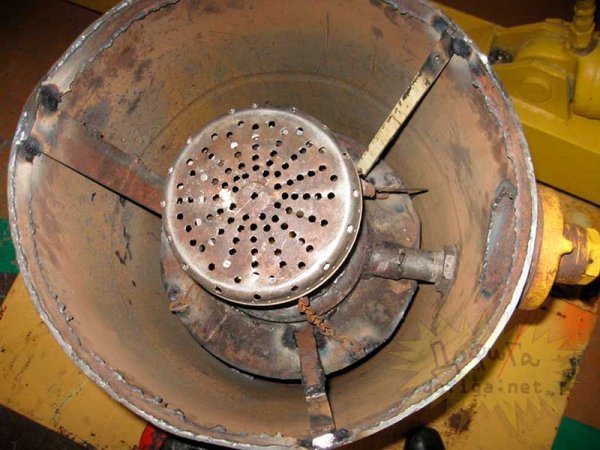
5. A cyclone filter is manufactured.
The use of charcoal or brown coal, peat, straw or other substances for traveling by car has a characteristic feature - the presence of dust.
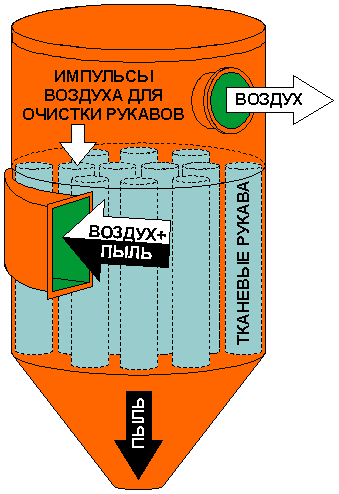
If you do not make a high-quality filter element, then dust can get into the carburetor, pistons, spark plugs and other components (including the interior).
You can find a ready-made solution right away.
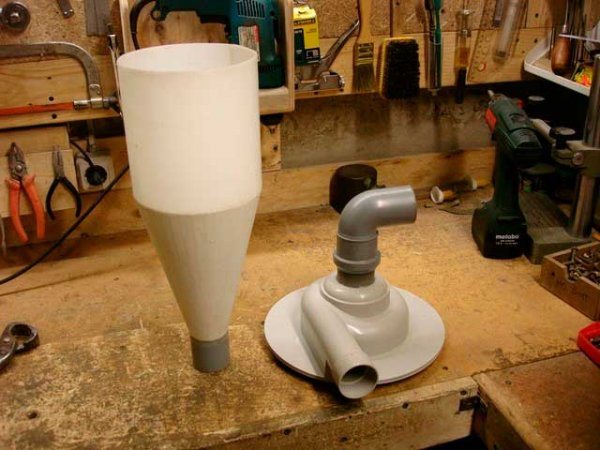
6. Making a radiator (cooler).
Any material can be used here. As an option, it is possible to use a standard heating radiator made of aluminum.
You can construct a device from water pipes. Please note that the cross-section of the radiator, as a rule, is slightly larger than the cross-section of the pipes connected to it.
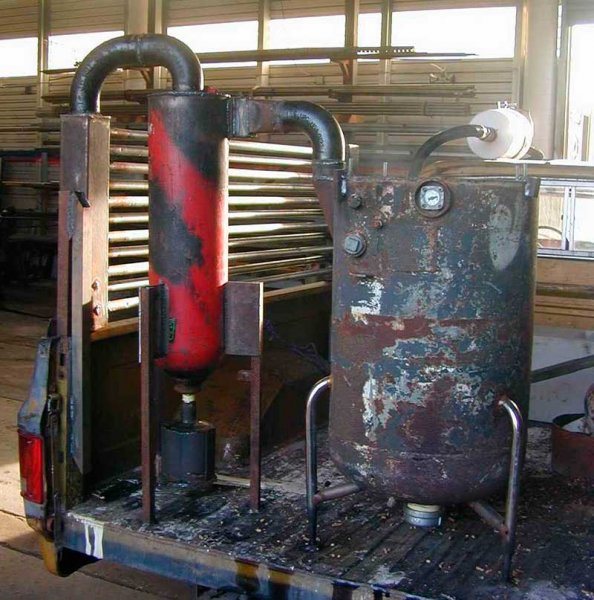
But still some take the simple route.
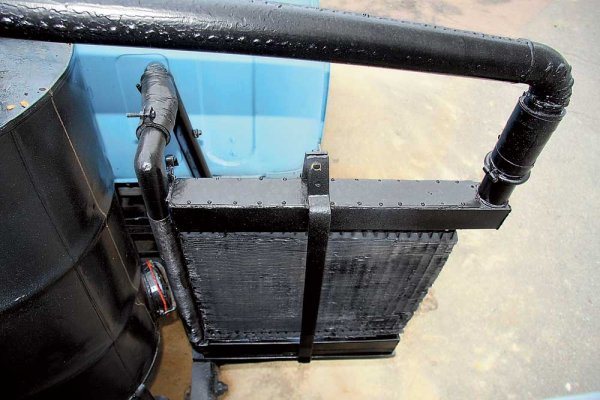
7. Manufacturing of a fine filter.
At the time of the first gas generators, fine filters were enormous in size and occupied a significant part of the car. However, the effectiveness was minimal.
Today we have modern materials at our disposal, thanks to which we can make a high-quality and compact filter at minimal cost.
In this case, the service life will be 10-20 thousand kilometers.

8. Fastening the gas generator in the trunk.
Here, as a rule, you will have to get rid of the luggage compartment lid to install a new device.
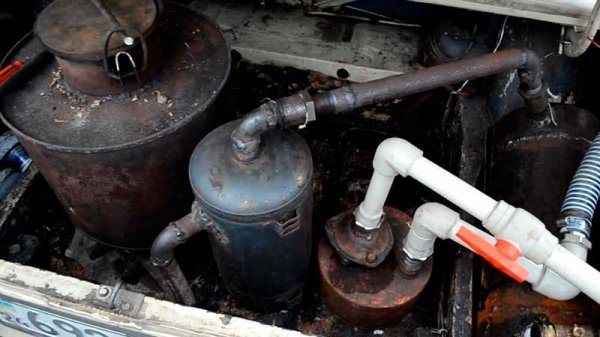
Some Kulibins hang the device behind the trunk. This is of course more practical, but it does not look very aesthetically pleasing.
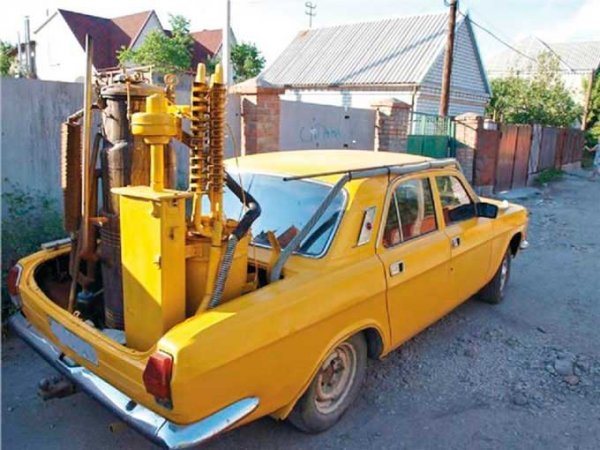
9. Connecting the gas generator to the motor.
The switching tubes through which gas is supplied are supplied to the engine.
At the same time, the main structural elements must remain intact.
Next, a calorie regulation system is organized from the car control panel.
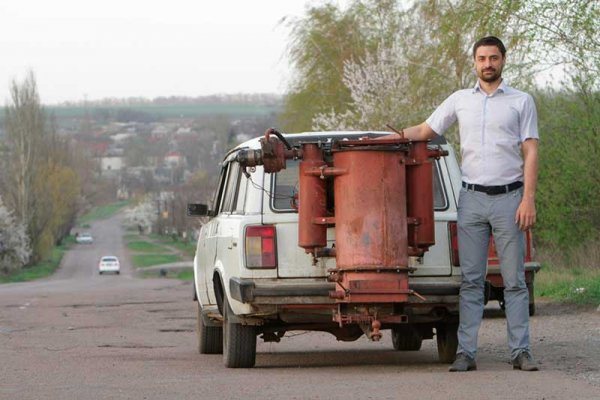
How to make a wood-burning gas generator with your own hands?
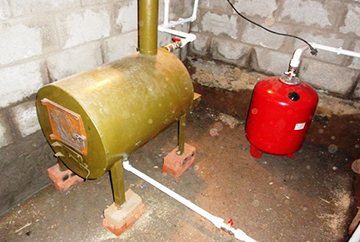
To manufacture a unit with a reverse operating principle, you will need:
- two containers of larger and smaller volume;
- sheet metal for the shaker (movable grates);
- water pipes;
- fan;
- round long tank for cyclone.
Manufacturing step by step:
- Two barrels of about 200 liters in volume are inserted one into the other. There will be a combustion chamber in the inner one.
- A two-inch pipe is welded in to supply combustion air.
- A hatch is installed on top for loading fuel, and in the upper part there is a pipe for removing the finished gas.
- The grate bars are suspended from the bottom of the central container in such a way that they can be moved from the outside, thereby clearing them of slag. And a blower door for cleaning.
- A centrifugal cleaning filter is welded separately from another container or pipe with a diameter of 20-40 cm.
- The cooling radiator is made of two thick pipes (about two inches), connected to each other by thinner ones. The height can reach two meters or more; it is selected individually according to the size and efficiency of the gas generator.
A fine filter is a container filled with:
- expanded clay;
- sawdust;
- metal washers or something similar.
You can use sawdust for fine cleaning only if you are convinced that the gas produced is already quite cold at this stage.
REGISTRATION WITH THE SAI
The most important thing is to register a car with a gas generator engine with the traffic police.
Here it is worth contacting the inspectorate in advance and clarifying the package of documents required for registration.
Unfortunately, in the CIS countries, legalizing cars converted for firewood is a very difficult task. The reason is the lack of GOST standards.
There are similar standards abroad, so the registration process takes a minimum of time.

Anyone who managed to register with the traffic police without problems, share your experience in the comments.
If someone has a motorcycle with a sidecar, then you can try to implement this option.
If you find an error, please select a piece of text and press Ctrl+Enter.
«>


